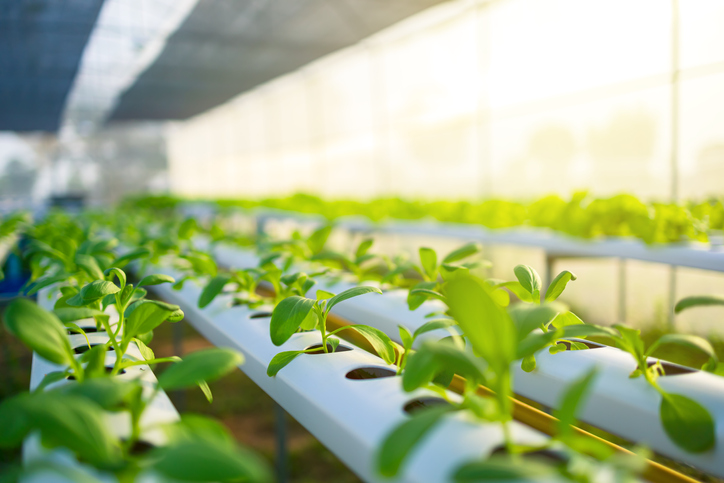Going green with hydroponics: 6 environmental benefits of water-based agriculture

Authored by AXA XL’s Daniel Guida and Scott Young
As an industry goes green, insurance responds to new needs
It’s estimated that by 2050, we will need to increase food production globally by a whopping 70% to meet the needs of a growing population. Based on the agricultural output from the last 50 years, we don’t stand a chance of meeting those needs.
Enter hydroponic farming.
Hydroponics has gained popularity as a more sustainable and efficient way to grow crops, and for good reason. Unlike traditional soil-based agriculture, hydroponics grows plants using water-based nutrient solutions and offers many benefits for the environment, including water conservation, reduced use of pesticides, energy efficiency, reduced land usage, and sustainable crop production.
The hydroponics industry is making significant contributions to a more sustainable future. Here’s how:
1. Water Conservation
You might think that because the system is “hydroponic” that it uses more water, but the opposite is actually true. Hydroponic systems recycle and reuse water, which minimizes waste and uses significantly less water than traditional, soil-based farming methods. These greenhouses also use watering systems that deliver water directly to plant roots, meaning little to no evaporation or runoff and plants receive only the precise amount of water that they need.
These efforts combined result in as much as 10 times less water usage than traditional farming methods.
2. Energy Efficient
Hydroponic systems are inherently energy efficient. The controlled temperature, humidity, and lighting is carefully managed to optimize plant growth, reducing the need for excess energy to maintain optimal growing conditions. LED grow lights are more energy efficient and can be customized to the specific spectrum of light that the plants need.
The water system mentioned above recirculates water and nutrients and requires much less energy to pump and distribute water. Lastly, many hydroponic greenhouses use energy-efficient heating and cooling systems, using less energy than even traditional greenhouses.
3. Fewer Pesticides
Hydroponics systems are less susceptible to pests and diseases, reducing the need for pesticides and resulting in fewer chemicals are introduced into the environment and a safer working environment for farmers. Studies show that pesticides can be spread by wind, infiltrate groundwater systems, and can kill insects, birds, and aquatic animals.There are also no weeds popping up, so herbicides aren’t needed.
4. Reduced Land Usage
Hydroponic systems are built vertically, taking up less space and minimizing land usage. In fact, a hydroponic greenhouse that uses just 1.5 acres can produce 2.7 million servings of leafy greens per year.
Take Gotham Greens, for example. Founded in 2009, the company operates more than 1.2 million square feet of hydroponic greenhouses across seven U.S. states. Their Brooklyn greenhouse, located on the rooftop of a Whole Foods, has become one of the largest greenhouse lettuce producers in North America.
5. Easier Access and Fresher Produce Means Lower Carbon Footprint
Many hydroponic farms are located close to – or even in – urban centers, requiring less land usage and easier access for communities that might not have fresh produce readily available.
Fifty-percent of fruits and 20% of vegetables that you find in the grocery store come from out of the country, which could take a week or more to get from the farm to the shelves. With hydroponic farming in urban areas, produce can get from greenhouse to shelf in less than 48 hours. Because products don’t have to travel as far, emissions are greatly reduced as compared to other options.
6. Sustainable Crops
Hydroponic systems create an optimal growing environment that allows crops to be produced year-round, in any location. This, paired with better control over nutrient delivery, can result in higher crop yields than traditional farming methods. Some companies report being able to grow as much as 240 times more crops using hydroponic methods than traditional farms.
Technology can also help with monitoring crop health and progress, allowing greenhouses to produce healthier produce, faster.
Risks in the Hydroponic Industry
Just like anything else, there are potential risks to this burgeoning industry, including:
Property damage: These systems and growhouses have a high start-up cost and any damage can result in significant financial losses.Water damage: If there is a leak or system failure, water damage can cause property and crop damage.Power outages: Hydroponic greenhouses rely heavily on technology to maintain optimal growing conditions, so a power outage can cause damage to the plants.Chemical handling: From nutrients to pH adjusters and more, chemicals are involved in hydroponics, so it’s essential that workers are educated on how to handle chemicals safely to avoid injury.
Insuring a sustainable future
Not all businesses are the same. And that’s why their insurance programs can’t be either.
From specialized lighting to growing trays, from water basins to temperature controls, the hydroponics industry relies on particular equipment and requires insurance coverage designed to protect their unique operations. Specialized insurance programs like GrowPro help hydroponic and indoor growing operations protect their facilities and mitigate their unique risks. In addition to the insurance provided, such programs also offer risk consulting services to help them take steps to prevent potential losses such property damage or worksite accidents.
Teaming up with insurance providers and risk management specialists with dedicated industry expertise helps greenhouse owners focus on what matters the most: growing their business and advancing a more sustainable approach to meeting future food demands.





